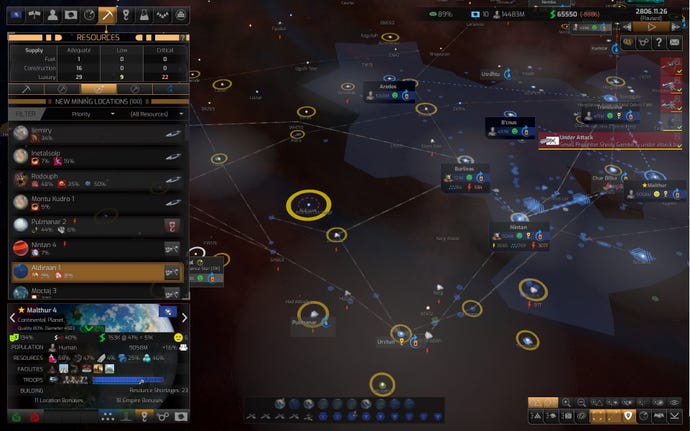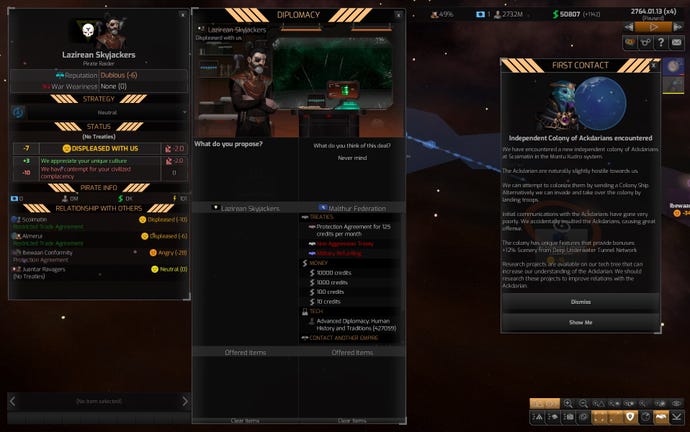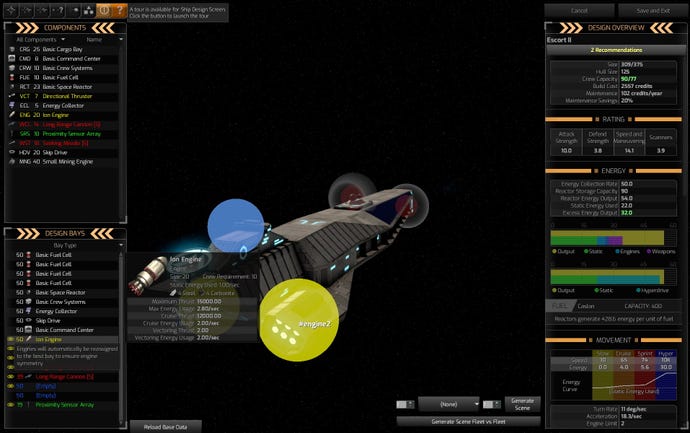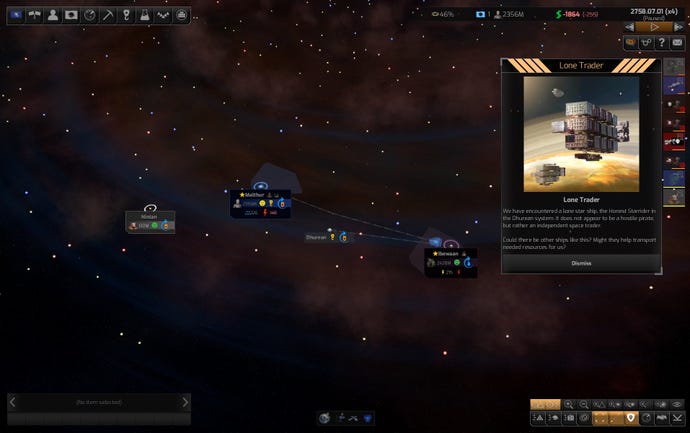Code Force played Distant Worlds 2 for us, and the signal is strong
This is "Distant Worlds rebuilt from the ground up," says co-designer Erik Rutins
Strategy games set in space are almost innately ambitious. The very concept of doing anything meaningful in an infinite void, let alone making it playable and entertaining, is a challenging one, and for every game that reaches for the stars there are countless kinds of... spiraling chaos orbitals.
Between its design flaws and unique ideas with semi-brilliant execution, the 2010 4X/wargame/economic/management simulation Distant Worlds: Universe has straddled those two experiences for a decade. It's needed a sequel for a long time. Distant Worlds 2 is that sequel, and it's almost upon us. Last week I attended a live demo and Q&A session with its producer and co-designer Erik Rutins. With only a hands-off demo to go on I obviously can't say for sure how it plays yet, but it's already looking very promising.
What's immediately clear was that, as a bare minimum, the UI is already vastly improved. DWU was complicated even by strategy game standards, and important functions and information were buried all over the place in obscure, full-screen menus. This sequel is instead built around a straightforward tabbed menu panel, integrated with the map so that hovering on an item pings the corresponding map location. It's fairly standard stuff in 2022, and the influence of Stellaris in particular is clear. But Distant Worlds was in sore need of a total presentation overhaul and Code Force have definitely prioritised clarity and ease of use. Pretty much every element Rutins demonstrates comes up with a summary of "top level" information with a click or two in a logical place.
This isn't just window dressing either. Rutins tells us immediately that "this is a 64-bit, multi-threaded 3D engine. It's a whole new code base... basically Distant Worlds rebuilt from the ground up." Players of the original will be relieved to hear that Distant Worlds 2 is based on "a newer engine that allows us to do bigger galaxies and 3D graphics, and not be constrained as much performance-wise. The old engine was beyond creaking at the seams."

Given that Distant Worlds already boasted tens of thousands of planets per game, that's a lot to manage, bringing us to the second area that badly needed improvements: the automation. Delegating tasks to the AI remains fundamental to the design, and Rutins stresses the importance of supporting a wide range of playstyles. Players uninterested in any aspect of running an empire can hand it to the AI, even so far as controlling only a single ship for themselves.
In between full automation and maximum micromanagement mode, many departments of your empire can be entrusted to advisors whose authority level is up to you - you might have them form the plans for your approval, or let them do what they want but occasionally send notice of decisions should you want to veto them. Each department can be further finetuned through 'policy settings' from within the same menu, essentially leaving specific standing orders for AI behaviour. Personally, getting the right degree of control without either constant messages or no idea what my ships were doing was always the first big hurdle with starting a DWU game. I'm hoping this approach will remedy those early stumbling blocks.
This attitude extends to diplomacy, too. Code Force's new policy layer only lets you make the big diplomatic decisions, and then gives your advisors broad instructions and "control at a somewhat higher level what your strategy will be". Here, he shows us that his diplomats are instructed to 'undermine' a neighbouring faction without him having to think up passive aggressive remarks himself. The list of playable factions has been cut from 20 to seven "because each faction frankly is a huge amount more work than it was in Distant Worlds". It's a small disappointment, but should still allow wide range of playstyles, and the remaining species will be available as independents who provide bonuses if conquered or peacefully assimilated.

From the sound of it, those factions are closer to Alpha Centauri than Stellaris, setting a loose archetype that you can bend, but not fundamentally change beyond a different government type. There are more factors affecting foreign relations, and new treaty types, the most interesting being multiple trade agreements. Initially, empires won't trade with you at all, but may sign a series of treaties to share increasingly favourable economic terms. When I ask, Rutins indicates that although it would depend on circumstance and good relations and treaties, it should be possible to trade extensively rather than mine everything yourself.
Inevitably, I asked whether I could be a pirate faction. The answer is no, for now, but "we really want them to the playable again in the future". Reading between the lines, it's almost certainly a question that will be answered by how well the game sells. DWU's pirate mode was a fundamental structural change, and asking for that out of the box is a lot, especially for such a small studio. But there will still be AI pirates to fight and bargain with. They're even integrated with the (optional) storyline, which Rutins says will offer "way more story than the first game."

He continues: "We have the main story, which is equivalent to the first, and a story for each faction. You really only get all the pieces of the entire narrative if you play through each faction." Less completionist players might still piece together what they miss with one faction though, as "we try to put everything in the galaxy at the beginning, and make you have to find it. But the order that you find it, and what happens, is up to you." This is true of the main and faction stories; any faction can find parts of any other's story, but may be less able to understand their significance.
Much of the new design is about refinement and better integration.
Much of the new design is about refinement and better integration, like the new ability to set immigration policy on a per-planet basis rather than just empire-wide, and the same is true for resource storage policies. Civilian transports will manage deliveries and stock levels as before, but you can alter their priorities to stockpile or clear out any given resource from any planet or station. Also like DWU, everything in your economy is physically present on the map, with every ship made from materials mined and shipped from place to place.
Each ship needs fuel too, although this time there's just the one fuel type, which I'm mildly disappointed by, but is probably a better design decision. Planetary populations, meanwhile, demand luxury resources to keep growing. Larger colonies pay more tax, but require ever more goods, which is still key to how DW2's economy works. The private sector will mine and transport those goods, but only as effectively as your state infrastructure permits. Growth and construction and research flourish when your mining and hauling network is well managed and protected, but poor planning, disruption from war and other disasters dampen that movement and those processes.

Building, colonisation, and fleet building and formation all have one-click purchase orders added in easily-accessed places, and your full build order can be viewed at a glance and rejigged with minimal fuss. Exploration ships have new, more nuanced AI settings to differentiate between basic exploration, prospecting, and spying. Even civilian transports show up on one menu tab, complete with their cargo or passenger manifest and a wee line on the map showing their flight plan.
One of many details that experienced players will recognise as a potentially huge problem solver is the replacement of fiddly and unreliable supply ships with fuel tankers. These too can be supervised and manipulated from an accessible list, but more crucially will now seek out and deliver fuel directly to fleets, keeping them from abandoning their posts to fly back to a fuel source. At one point, Rutins even says my holy word: "salvage". In addition to the old system of recovering derelicts, destroyed ships can now leave behind debris, from which you can salvage resources, money, or scraps of knowledge.
This talk of ships brings us to the design screen. DWU had a somewhat abstracted ship design process. DW2 replaces that with a 3D hull and hardpoint-based system. Each hull has predefined bays, including weapon mounts that also define the field of fire. You can still choose the equipment you want, but the parameters look more restrictive. On the plus side, this leaves room for more differentiation between hulls and factions. If anything's contentious among fans, I suspect it will be this, but it certainly appears to be easier to work with, and adds a little more to the sense of drama already offered by the shift to 3D graphics. Planets are no longer icons only a few sizes larger than a ship, but big ol' orbs, which "does affect the tactics too, because you can't cover the planet with just one spaceport anymore. You usually need a defensive fleet, or several orbital bases to fully cover it from attack."

Sensor stations will help with this, as should the new "dangerous locations" menu, which records threats like space monsters and pirates, plus when you last scouted the area. This should hopefully keep scouts and builders out of trouble, and give you a better picture of how the galaxy is shaping up at a glance. There's plenty of war to be mongered too, of course. As of last week, Code Force have another layer of detail to add to fleet automation, but in keeping with the other departments, the gist appears to be that there are more AI routines for different types of attack, and they intend to add levels of delegated management between full control and full auto as they have elsewhere.
DWU's three research trees are now merged into one (you can still spread research over three items at a time if you prefer), but you're now blind to undiscovered technologies. There's a lot more than what the player sees, Rutins says, so how the research tree connects each time can be different. It's not the classic 4X one school research system either; I sneakily counted ten sub-fields on screen like shields, engine, and industrial research. Each research facility apparently specialises somewhat, as do recruited scientists. We didn't get time to get into the character system, but I caught a glimpse of a scientist adding to a research rate, and an ambassador directly improving a diplomatic relationship.

More information rapidly becomes an ever-increasing list of small details. I get a strong impression that Rutins (and co-designer and developer Elliot Gibbs, who wasn't present but their work certainly was) has attacked a great many of the little problems Distant Worlds had, and tied the solutions all together with the kind of thankless interface and data management structures that can dramatically multiply their effect. Of course, I can't tell for sure how successful they've been without playing, but when I compare how smooth it's looking with how clumsy and laborious an equivalent demo of the original would have been, I'm finding it hard to be cynical.
Distant Worlds 2 is currently due out on March 10th. We'll have more impressions and thoughts as soon as we can get anything more substantial.










